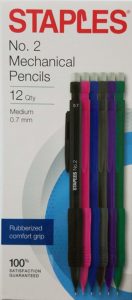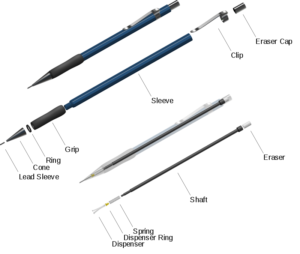STAPLES No. 2 Mechanical Pencil
Technical Description by Mohammed Islam

Figure 1: Package of Staples No. 2 Mechanical Pencils
Table of Contents
Introduction Page 1
Description Page 2-3
Functions and Uses Page 4-5
Conclusion Page 5
Works Cited Page 6
Introduction
The mechanical pencil is a writing utensil that functions mechanically to push lead out through the tip in order to write. This is a type of pencil that uses refillable 0.7 lead. The mechanical pencil is purposed to be a more efficient pencil because it took away the need of sharpening pencils. When the lead is running out you squeeze the end with the eraser vertically down into the shaft. This will mechanically dispense more lead. The mechanical pencil conveniently has an eraser at the end of it the same way a pencil will have one and are also replaceable. The mechanical pencil is also known as lead pencil.
The first form of a mechanical pencil didn’t work the same way one does today. The idea of a mechanical pencil was invented in 1565 by Conrad Gesner. His form of a mechanical pencil pushed lead out that needed to be then sharpened to write with.
Then, in 1977 when HMS Pandora- ship of Royal Navy that sank in 1791- was found at sea, a more modern form of the mechanical pencil was discovered. This modern mechanical pencil that had replaceable lead was patented in 1822 by Sampson Mordan and John Isaac Hawkins in Britain. Sampson Mordan then decided to start a business manufacturing them. However, his company “S. Morgan & Co.” was discontinued after the factory was in a bombing in World War II.
The Staples No. 2 Mechanical Pencil is sold online and in stores at Staples. These pencils are not sold individually but in packs of 12 or 24. A 12 pack of mechanical pencils can be priced at about $6.00 which makes each mechanical pencil itself worth about $0.50. These are not made to last a long time but rather for a decent period where you use and dispose of it. However, it can be used for as long as the user keeps it in working condition.
Description
The parts to a Staples mechanical pencil are pretty much the same for any basic Mechanical pencil. For a clearer understanding, the parts can be split up into two categories: interior and exterior.
Exterior parts:
The exterior parts of a mechanical pencil are the parts that can be viewed from the outside.
- Lead- This is the material that touches the paper and leaves a mark. The lead is 0.7mm lead.
- Cone Sleeve- The cone sleeve helps direct the lead through the tip of the pencil.
- Ring- The ring reduces stress on the cone sleeve from the pressure the user puts on the pencil sleeve.
- Grip- The grip is made of rubber and allows the user of the pencil to write without slipping.
- Sleeve- The sleeve is a tube-like cover for the shaft.
- Clip- The clip is used to hang a mechanical pencil.
- Eraser Cap- The eraser cap is used to cover the eraser.
Interior Parts
The interior parts of a mechanical pencil are the parts that are inside of the pencil and cannot be viewed from the outside.
- Dispenser- allows lead to dispense through the cone sleeve.
- Dispenser Ring- allows the dispenser to connect to the spring.
- Spring- pushes the shaft back after being compressed.
- Shaft- pathway and storage area for lead.
- Eraser- used to wipe away marks made by the pencil in case of a mistake.
These are the parts that make up a mechanical pencil. Some parts may be altered or connected in other mechanical pencils. In addition, not all mechanical pencils include an eraser cap such as the Staples No. 2 Mechanical Pencil.

Figure 2: Mechanical Pencil Diagram
The Staples No. 2 Mechanical Pencil appears as lightweight. It come in a box with a mixed variety of colors. The material used for these pencils are mostly plastic aside from the lead, grip, eraser, spring, and rings. The shape of the sleeve is hexagonal. On the sleeve the writing “STAPLES NO. 2” is written horizontally. On the end of the shaft right under the eraser the writing “0.7” is written vertically. The grip also has circular lines which help grip the pencil better when writing. The pencil is about 6 inches long.
Functions and Uses
The Staples No. 2 Mechanical Pencil is a very simple and basic mechanical pencil. Its purpose is to write with and is meant to be convenient. To use, you first press the eraser end until desired length of lead is displayed. Second, you grip the rubber grip piece where it is easiest to hold and start writing. However, because of how thin the lead is, you should be aware of how much pressure you put on to the pencil because lead strips used in mechanical pencils have the tendency to snap when enough pressure is placed on it. The mechanical pencil is a very simple innovation that has proven to be very helpful and is being used across the world today.
The mechanical pencil also not only allows you to take out lead through the tip, you can also push lead back inside. This can come in handy when you are finished using the Pencil and want to store the pencil away. Because the lead is very thin and exposed when writing, you can push it back in by pressing down on the shaft which loosens the dispenser and allows you to push the lead back inside, so it is not visible from the outside. This can help prevent the lead strip from snapping into pieces.
Lead in mechanical pencils are refillable. The proper way to refill a mechanical pencil is by first removing the eraser from the end of the shaft. Under where the eraser normally sits is a whole. This is where you can put pieces of lead down and refill the pencil. After you have refilled the pencil, put the eraser back on and press down on the shaft a few times until your lead makes its way through the shaft and the dispenser. Packs of lead can also be purchased separately for refilling purposes.
The erasers on mechanical pencils are also replaceable. After they wear out and shrink in size, you may replace the eraser if desired. To replace the eraser from the Staples No. 2 Mechanical Pencil, you must pull the eraser off the shaft. This may be harder to do as the eraser gets shorter. Next, you take a new eraser and fit it in the whole on the end of the shaft where you can refill lead from. Then it should be pushed all the way down and it is ready for use.
Conclusion
In conclusion the Staples No. 2 Mechanical Pencil is a very convenient pencil. It is a good option economically and physically as it has distinct differences in its manufacturing compared to a pencil. For example, a Mechanical pencil is made of mostly plastic, while a pencil is made up of mostly wood. This makes the mechanical pencil more desirable for use. Its presentation is also very nice as it comes in a variety of many colors. It is a genius innovation that allowed us to write with in pencil without the hassle of sharpening a pencil or dealing with splinters from the wood. The mechanical pencil is about the same width as a regular wooden pencil. The innovation was successful because it has reached many countries around the world.
Works Cited
“History of the Mechanical Pencil – Inventor of Mechanism.” History of Eraser – Facts, Types and Invention, www.historyofpencils.com/writing-instruments-history/history-of-mechanical-pencils/.
Figure 1 “Staples No.2 Mechanical Pencils, Medium 0.7 mm (12 Qty)” Amazon posting by Rockledge Retail
Figure 2 Pbroks13. “Mechanical Pencil Diagram.” Wikipedia, 25 Nov. 2018, en.wikipedia.org/wiki/Mechanical_pencil#/media/File:Mechanical_Pencil_Diagram.svg.
Ryan. “The Beginner’s Guide to Mechanical Pencils.” Love at First Write, Jetpens, 20 Mar. 2018, www.jetpens.com/blog/the-beginners-guide-to-mechanical-pencils/pt/957.


